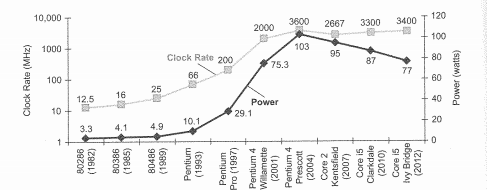The end of Chapter 1
- If you have not yet done so, READ CHAPTER 1.
- 1.7 the Power Wall
- They tell us energy is directly related to a load on each transistor (called Capacitive load) and the square of the Voltage
- Energy ∝ 1/2 Capacitive load × Voltage2
- Further they tell us that power is
- Power ∝ 1/2 Capacitive load × Voltage2 × Frequency Switched.
- In this case, Frequency Switched is the clock rate.
- Typically in each generation, we were able to drop by voltage.
- Hence the table on page 40 showing an increase in speed but a smaller increase in power.
-

- They say that we have seem to have hit a limit for reducing voltage.
- So we can't continue to drive our chips faster.
- 1.8, The Sea of Change.
- So what have we been doing with the extra transistors?
- Multiple Cores
- Is this a good solution?
- As I type on my machine I am
- using an editor (very few cycles really)
- listening to Pandora (a few more cycles)
- running my browser.
- And my xserver, and other things...
- running a web server (early Sunday afternoon, no one is using it)
- All of these tasks can run on a different core
-

- And the easiest type of parallel processing is demonstrated here.
- But what about "faster programs"?
- Parallel programming is generally much harder than sequential programming.
- Introduce Flynn's
- The easiest type is SIMD
- Single Instruction Multiple Data
- This is what happens in GPUs.
- A task (such as drawing a bunch of pixels) is split among a bunch of processors.
- Only works in very parallelizable situations.
- The hard type is MIMD in a single task
- Multiple Instructions Multiple data.
- Coordinating tasks, data are major problems.
- Many issues (deadlock, race conditions, ...)
- Take OS to learn about these.
- 1.9, Benchmarking the Intel Core i7
- Over the years there has been an attempt to generate a "true" measurement of performance.
- This would allow consumers to compare processors.
- SPEC (System Performance Evaluation Cooperative) (or Standard Performance Evaluation Corp)
- Establishes standards for processor comparison.
- Based on a number of different measures. (See page 47 or look here.
- The standards evolve over the years.
- But the higher the number the better.

